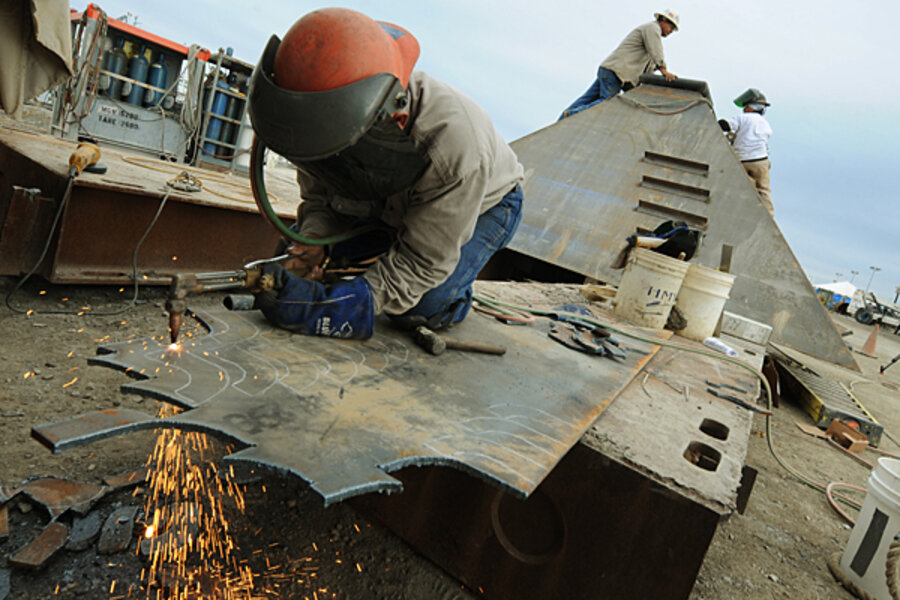How to stop the BP oil spill: What else can be tried now?
Loading...
As oil from an offshore drilling blowout spreads across the northern Gulf of Mexico, engineers are scrambling to staunch the flow of crude with everything from deep-sea submersibles to a little-tested approach for capturing the oil in a special structure hovering just above the well head, then pumping the crude into waiting ships or barges.
The need for a menu of approaches illustrates the challenges to capping a blow out some 5,000 feet below the sea surface.
"There is a silver bullet; it's drilling relief wells," says Jerome Milgram, an ocean engineering professor at the Massachusetts Institute of Technology in Cambridge, Mass., who has extensively studied ocean-rig blowouts and their effects.
IN PICTURES: Louisiana oil spill
But, he adds, "that takes time" – and time is a commodity in short supply as engineers grapple with ways to corral the crude and remove as much as possible before it can join the quickly spreading slick at the surface.
The Deepwater Horizon oil rig, destroyed April 20 in an explosion and fire that killed 11 workers, is spewing some 200,000 gallons of oil a day on the sea floor.
Regardless of how well current efforts to stem the flow go, relief wells likely will be required, says Dr. Milgram.
Earlier today, the chief executive officer for British Petroleum, Anthony Hayward, noted in an interview with National Public Radio that work on relief wells began May 2. In the meantime, crews have deployed eight remotely piloted submersibles to try to use their claws to "manually" shut valves on a device at the wellhead, known as a blowout preventer. All the systems designed to automatically trigger the blowout preventer failed during the initial event.
Hope in a huge range hood
Beyond that, Mr. Hayward explained that, by the weekend, technicians should be ready to lower a containment structure over the well head designed to capture the oil and pump it to the surface.
That approach has been used once before – in 1979 during a blowout involving the Ixtoc exploration rig in the Bay of Campeche off Mexico. It was the first attempt at using the technique, and it didn't work, says Milgram, who was at the site conducting research on the operation at the time.
Many of the reasons stemmed from engineers attempting something that hadn't been done before – in that case, lowering what he calls a steel sombrero over the wellhead, which was spewing oil and natural gas.
A pipe running from the peak of the sombrero to the surface carried the mix of oil, gas, and sea water into a separation tank on a barge. The device needed no pumps; the gas did all of the pushing as it gathered under the peak, Milgram says.
But the team experienced a range of problems that eventually led them to jettison the idea. In effect, the system was too small, based on initial, ultimately incorrect estimates of the amount of oil and gas leaking from the well. In addition, the team had a tough time positioning the sombrero over the wellhead; sea-floor wreckage from the blowout impeded the work. And the quantities of oil, gas, and water were far larger than the team was prepared to handle.
The containment covers technicians are building for this event look more like oversize range hoods for kitchen stoves, Hayward said. These 74-ton steel and concrete structures will aim to guide oil and any gas up toward a pipe at the peak and into waiting ships for separation.
If the containment covers are big enough, and if technicians can bring the oil and water to the surface and separate them adequately – either naturally or by using powerful pumps – the covers "might diminish the amount of oil that gets into the environment by some significant percentage," he says.
This will be the first time anyone has tried the approach in such deep water with its enormous pressure. The Ixtoc blowout, which ultimately lasted nine months, occurred in 165 feet of water.
And if that doesn't work?
One other option exists – stacking another blowout preventer on top of the faulty one. But while that's been done on land, it hasn't been done underwater with a flowing well, says John Smith, a petroleum engineer at Louisiana State University in Baton Rouge.
"A major consideration has to be that you don't want to make the problem worse," if something goes wrong while trying to install the added blowout preventer, he says.
Meanwhile, researchers have been experimenting with improvements to blowout protectors, which rely on hydraulics to shut off a well. Engineers at the University of Houston have been experimenting with blowout preventers that rely on so-called smart metal alloys to open and shut them. These alloys contract when heated, then return to their initial shape when cooled.
The team designed cables from these alloys, and using electric currents, induced the cables to open and close off a drill hole. The team estimates that a scaled-up version could shut off a highly pressurized well pipe within about 15 seconds of being triggered by special sensors.
At the least, the approach represents a potential back-up to existing blowout preventers, says Gangbing Song, who led the design team.
IN PICTURES: Louisiana oil spill
Related:
Town where Katrina made landfall now braces for BP oil spill
Distrust hampers BP effort to enlist fishermen in oil spill flight





